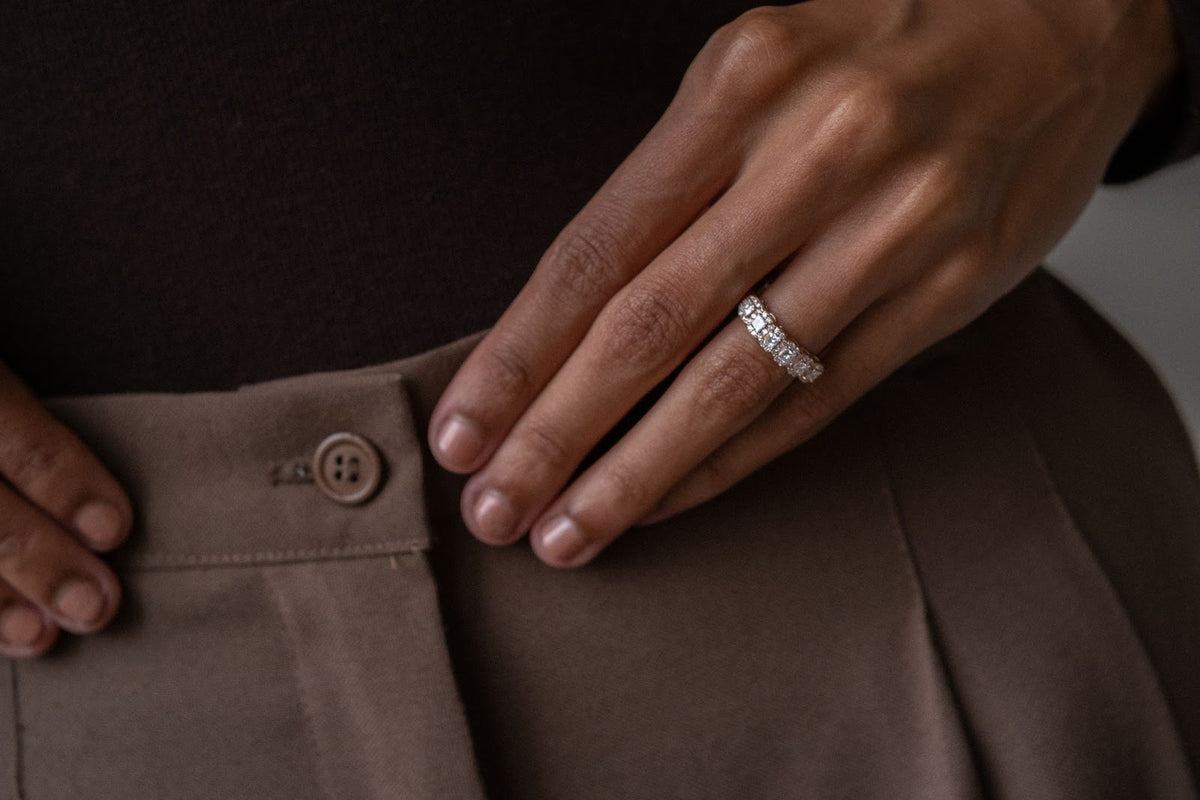You’re down to the wire with buying your loved one a memorable gift for their birthday. They mean the world to you, and you want to show them that with a diamond ring. After searching for the right one, you stumble across an option that looks just right for your person. It arrives, and you’re all ready for that special moment when you get to see them open the gift that symbolizes your devotion.
With wide eyes, they lift open the box to reveal what you thought was a perfect find. You slide the ring on their finger and think of how picturesque the moment is. Everything about the moment seems perfectly authentic and lovely. Then suddenly, the question comes up, “Is it real?”
Variances
Buying diamonds can be perplexing if you’re not a gemologist. The ordinary eye can’t identify the slight variances between a real diamond and a good fake. Despite this, you’d probably still like to know if the diamond you’re choosing is as legitimate as its price tag claims. Let’s examine a few of the common variances between real diamonds and their lookalikes.
Color
You may have heard that real diamonds only reflect white light. While it’s true that they do reflect white light, authentic diamonds also reflect rainbow light. When considering the color of your diamond, something to keep in mind is that a Cubic Zirconium lookalike can either be completely clear or have a vibrant rainbow reflection.
With this in mind, keep to the middle of the road with white and rainbow light reflections. An authentic diamond will showcase a brilliance that doesn’t lean to either extreme.
Scintillation
The differences between real and fake can be so minute to an untrained eye that several precious stones can mimic an authentic diamond’s scintillation, or sparkle.
If it sparkles, is it real? It just might be, depending on what you mean by the word “sparkle.” Gemologists use the word scintillation to refer to the way a diamond interacts with light. Scintillation is not only a stone's sparkle but also the patterns of light and dark within the interior space of a diamond. These patterns are created when the diamond reflects itself internally.
Other visual qualities to consider in determining whether your diamond is genuine are its brightness and its fire. Brightness refers to the way a stone reflects white light when it is face-up, and fire describes the way a stone reflects a brilliant array of colors.
The visual appearance of gems also varies with the style of cut, the quality of cut, the lighting, the diamond’s cleanliness, and the number of facets within the diamond. These factors interplay and are worth considering when determining whether a diamond is fake.
A diamond may be authentic but could have been cut differently or could contain fewer facets than another diamond that appears to be more brilliant.
Hardness
Another tell-tale sign of a diamond’s authenticity is how hard it is. Diamonds are the world’s hardest substance, with a Mohs Hardness Scale rating of 10. This means that it can leave scratches on other things, but nothing can leave scratch marks on a diamond. If it has lots of scratches across its surface, it may not be the real deal.
Inclusions
Inclusions result naturally from the growth process of precious gems. They are little imperfections that are usually not able to be seen by the naked eyes.
Some gemologists can use what is called a Loupe to examine the facets and junctions of a diamond to grade diamonds. Unfortunately, an untrained person would not likely be able to tell the difference between an authentic diamond’s inclusions and imperfections in a synthetic imitation.
In general, real diamonds have slight imperfections, although these are often imperceptible to the naked eye. A completely perfect stone is a red flag in determining whether a diamond is real or fake.
Can Your Diamond Stand These Tests?
Though not 100% accurate, there are multiple tests you can perform to find out if your diamond is real or if it’s an imitation. These would be easy at-home ways to give you a bit of peace of mind.
At the very least, dramatically bad results would show that your stone is most likely inauthentic. However, the results of any of these tests are only guesses compared to the judgment of an expert jeweler.
Fog Test
The first test is an age-old trick to try to tell if a diamond is what it appears to be. It also can be done on a diamond that is securely set, unlike some tests that require your diamond to be loose. You can try this in your home with your own jewelry. This makes it the easiest, quickest way to find out if your precious gem is truly a fake.
Breathe on the stone in question to see how it reacts to the humidity. A CZ or other diamond imitation will fog up and will stay foggy for several seconds. This has to do with the way synthetic stones react to condensation.
A real diamond is less likely to fog-up in the first place, let alone stay retain a cloudy appearance for several seconds.
Under Fire
This test is nerve-wracking, to say the least, because its results can be extreme. This is only for stones which you’re okay with damaging altogether if they turn out not to be real, so don’t take this test lightly.
If it’s real, your diamond will be fine. If it is an imitation, your gem could become discolored, could internally break, or could even shatter completely.
First, you’ll need a glass of water and a safe, open source of fire. You might even want to wear protective goggles or gloves to ensure that you’re safe from being burnt. Using a fire-safe tool, grab your gem and hold it over the fire for 30 seconds to a minute so that it’s thoroughly hot. Then, drop it in the glass of water. If it’s real, it should remain intact and unharmed. If your stone is an imitation, it will likely shatter internally or externally.
Full Transparency
If you’re looking for a less risky test, try the transparency test. You’ll need a piece of paper with text printed on it and sharp eyes. Place your loose stone face-down onto the printed text and try to examine the text through the stone.
The idea of this test is that if you can read it, your stone is probably not authentic. The brilliance and cut of a quality, authentic diamond should bend the text and make it slightly unreadable.
Sink Or Float
Though this test also requires you to have access to a loose gem, it still is relatively low-risk compared to the fire test. You’ll need a glass of water that is easy to see through and a loose stone.
The idea behind this test is simple: a CZ or other diamond imitation will float, even if just briefly before sinking slowly. A real diamond should sink more quickly to the bottom.
All Kinds Of Imitation
Several common stones mimic the appearance of a diamond but are less valuable. It might help you to become familiar with the imitation alternatives out there that are sometimes deceptively marketed as diamonds. Though you may not be an expert jeweler, you just might be able to spot a characteristic that saves you from being sold something inauthentic.
In Summary
Though you may want to determine a diamond’s genuineness, there is an unfortunate truth to take into account. Each of these tests has its downfall when it comes to accuracy.
The most trustworthy way to tell if a stone is truly real is to buy from a reliable jeweler with reputable practices. At Noémie, we have your best interest in mind by providing quality diamonds that are both brilliant and ethically-sourced.
Not only that, authenticity is guaranteed at Noémie. Every piece of jewelry is hand inspected by the International Gemological Institute (IGI), and you’ll receive an IGI certification card with your jewelry. This will tell you everything that you need to know about your stone, from the color and clarity of the diamonds to the appraisal value.
Replay your scenario. After exploring the collections at Noémie, you purchase the perfect expression of the feelings you have for your loved one. The day has finally come when you have the chance to gift this diamond expression to them. With wide eyes, they open your gift and, in amazement, ask, “is it real?” With every bit of confidence, you reply, “Yes, it is.”
Sources:
https://www.brides.com/how-to-tell-if-a-diamond-is-real-4799253
https://4cs.gia.edu/en-us/blog/how-to-tell-if-diamond-is-real/
https://www.capetowndiamondmuseum.org/blog/2017/01/how-to-tell-if-your-diamond-is-real-or-fake/
https://www.businessinsider.com/5-ways-to-spot-a-fake-diamond-2017-7#-1




